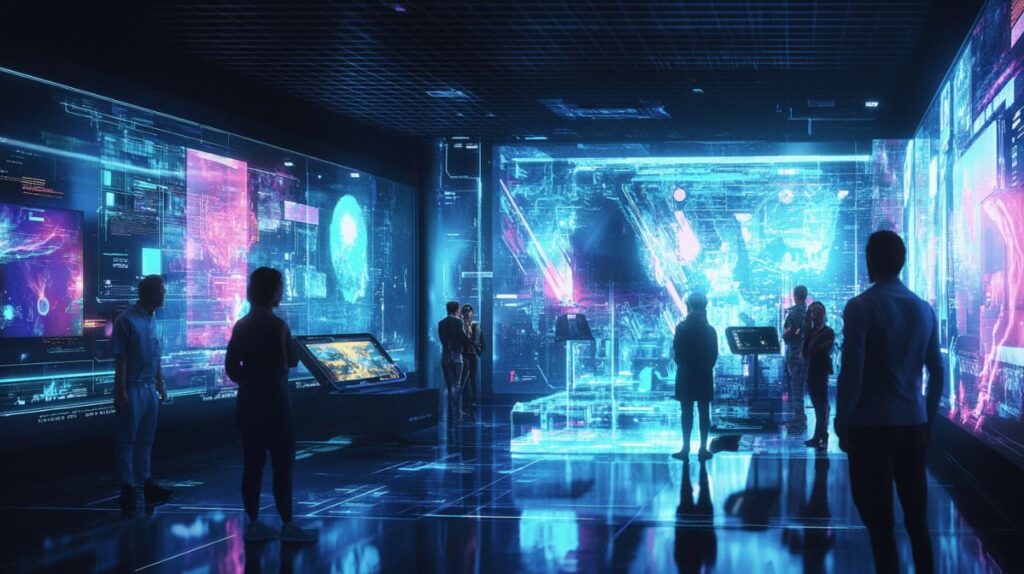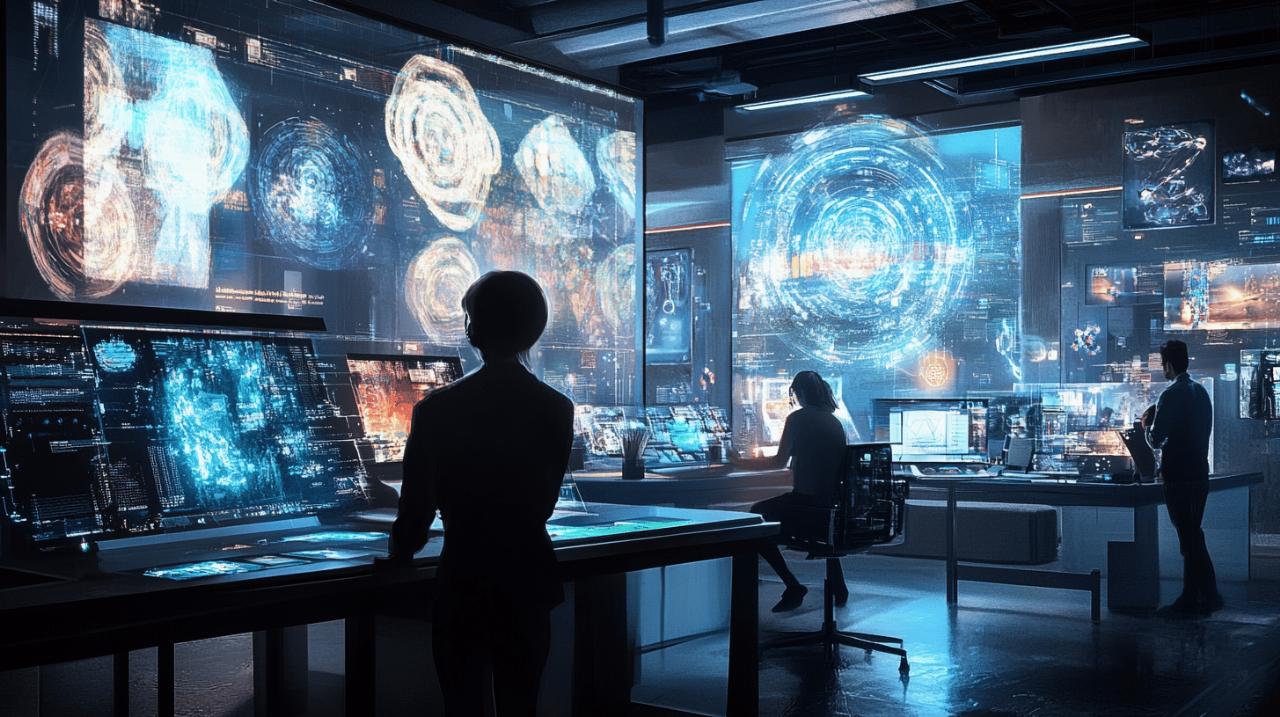
The landscape of artistic expression is undergoing a radical shift as digital tools empower creators with unprecedented capabilities. Intuitive image generation technologies are reshaping how we conceptualize, create, and distribute visual content across disciplines.
The digital revolution in creative processes
Modern AI-powered platforms are fundamentally altering traditional workflows in art and design sectors. These technologies combine sophisticated deep learning algorithms with user-friendly interfaces, enabling rapid iteration and experimentation that was previously impossible.
Breaking traditional barriers through accessible technology
The rise of text-to-image conversion tools like Stable Diffusion and Dall-E has dismantled longstanding technical obstacles. Artists can now generate complex visuals through simple text prompts, while My Image GPT offers users the ability to create stunning visuals without extensive training. These platforms incorporate advanced features such as style transfer, inpainting, and custom model training that previously required specialized expertise.
Democratizing art creation across skill levels
Image generation tools are leveling the creative playing field by providing capabilities to users regardless of their technical background. From free plans offering limited daily credits to professional subscriptions with unlimited generations, these platforms scale to different needs. Beginners can explore artistic styles and composition techniques while professionals leverage bulk creation and character consistency features for commercial projects.
User-friendly platforms reshaping visual expression
The landscape of artistic expression and design has undergone a remarkable transformation with the advent of intuitive image generation tools. These platforms harness the power of AI to democratize visual creation, making sophisticated design capabilities accessible to users regardless of their technical expertise. From marketing professionals to independent artists, these tools are enabling new forms of creativity across disciplines.
Text-to-image generators simplifying complex visualization
AI image generation technology has revolutionized how we translate ideas into visual content. Systems like Stable Diffusion and Dall-E employ deep learning algorithms to analyze and interpret text prompts, producing detailed and contextually relevant images that align with user specifications. These platforms offer extensive functionality including text-to-image conversion, style reference implementation, and pose reference capabilities that previously required advanced technical skills. Users can now generate high-quality marketing visuals, stock photos, logos, and artistic compositions by simply describing their vision in words.
The accessibility of these tools extends to various subscription levels, with many platforms offering free tiers that allow users to create images up to 1024×1024 pixel resolution. More advanced subscription plans provide additional benefits such as increased parallel generations, access to custom fine-tuned models, and unlimited credits for professional users. This tiered approach ensures that both casual creators and dedicated professionals can leverage AI image generation according to their specific needs.
Interface design principles behind successful creative tools
The effectiveness of modern image generation platforms stems largely from thoughtful interface design that prioritizes user experience. Leading tools in this space offer intuitive editing capabilities including inpainting, style transfer, background manipulation, and specialized features for fixing common problems like unrealistic hands or facial expressions. These interfaces are designed to be boundary-free, often making prompts optional rather than mandatory, which encourages experimentation and creative exploration.
Beyond basic generation, these platforms are expanding into comprehensive creative ecosystems with features like image-to-video conversion, AI filters, sketch-to-image transformation, and QR code generation. Many tools also support community engagement through Discord servers where users can connect, share ideas, and collaborate. The most successful platforms provide educational resources such as prompt books, model training guides, and video tutorials to help users maximize their creative potential. By combining powerful AI technology with user-friendly interfaces, these tools are enabling artists, designers, and marketers to produce sophisticated visual content for websites, e-commerce, entertainment, and artistic expression without the steep learning curve traditionally associated with professional design software.
From concept to creation: streamlined workflows
 AI image generation tools have revolutionized visual content creation across industries. Today's intuitive platforms like Stable Diffusion, Dall-E, and MyImageGPT empower users to produce sophisticated visuals without extensive technical expertise. These systems leverage deep learning algorithms to analyze and replicate visual data, creating images that closely resemble real-world content while allowing for creative exploration and customization.
AI image generation tools have revolutionized visual content creation across industries. Today's intuitive platforms like Stable Diffusion, Dall-E, and MyImageGPT empower users to produce sophisticated visuals without extensive technical expertise. These systems leverage deep learning algorithms to analyze and replicate visual data, creating images that closely resemble real-world content while allowing for creative exploration and customization.
Rapid prototyping capabilities for designers
The emergence of AI image generation has fundamentally transformed the prototyping process for designers. Graphic designers now experiment with diverse artistic styles and create logos, website graphics, and marketing materials in minutes rather than hours. Through text-to-image conversion, designers can quickly test multiple concepts by adjusting style, color, and composition parameters. Advanced features like style transfer, pose reference, and composition reference further enhance creative possibilities. The ability to train customized models allows designers to maintain brand consistency while exploring variations. Many platforms offer specialized tools for logo generation, character creation, and e-commerce visuals, making rapid iteration accessible even under free plans that support resolutions up to 1024×1024 pixels.
Time efficiency gains in commercial art production
Commercial art production has seen dramatic efficiency improvements through AI image generation tools. Marketing teams create high-quality campaign visuals and social media content without waiting for traditional production timelines. Entertainment industry professionals utilize these technologies for detailed visual concepts in films and games. The time savings come from comprehensive editing capabilities including inpainting, background changes, magic removal tools, and facial expression adjustments. Features like bulk creation and parallel generation (ranging from 4 to 32 simultaneous processes depending on subscription tier) multiply productivity. Photo-to-video conversion extends the utility of static images into motion content. While free plans offer valuable starting points with daily credits, tiered subscriptions provide escalating capabilities from Starter (5,000 monthly credits) to Pro (unlimited credits) to match commercial demands. This technological evolution demands attention to ethical considerations around copyright and misinformation as these powerful tools reshape visual content creation.
Blending human creativity with ai assistance
The artistic landscape is undergoing a revolutionary transformation through AI image generation tools. Platforms like MyImageGPT, Stable Diffusion, and Dall-E are empowering creators across disciplines to produce stunning visuals without extensive technical expertise. These sophisticated systems leverage deep learning algorithms to analyze visual data and generate images that closely mimic real-world content, yet can transcend into realms of imagination that were previously difficult to access.
Finding balance between automation and artistic control
Modern AI image generators offer unprecedented flexibility, allowing artists and designers to maintain their creative vision while benefiting from technological assistance. Users can customize their creations by adjusting style, color, and composition through intuitive interfaces. The range of features is extensive – from basic text-to-image conversion to more advanced capabilities like style reference, pose reference, and composition reference. Tools such as InPainting, style transfer, and background manipulation give creators precise control over their visual narratives. Many platforms offer tiered subscription plans, from free options with basic functionality to professional packages with unlimited generations and custom model training opportunities. This spectrum of accessibility ensures that both casual creators and professional designers can find tools that match their needs.
Unique creative fingerprints in machine-assisted art
Despite using the same AI tools, artists are developing distinctive styles and approaches in machine-assisted creation. The AI serves as an intelligent collaborator rather than a replacement for human creativity. Industries including graphic design, marketing, e-commerce, and entertainment are rapidly adopting these technologies to enhance visual content creation. Marketers generate campaign visuals and social media content, e-commerce businesses improve product photography, and entertainment companies create detailed visuals for films and games. Graphic designers use AI to explore new artistic styles, generate logos, and create website graphics with unprecedented speed. The technology enables consistent character creation from single images or descriptions, boundary-free AI drawing with optional prompts, and even photo-to-video conversion. Communities are forming around these tools, with platforms offering Discord spaces for connecting, sharing ideas, and collaboration, creating new artistic movements at the intersection of human imagination and machine capability.
Future trajectories for intuitive creation tools
Intuitive image generation tools are reshaping the landscape of art and design, empowering creators with unprecedented capabilities. These AI-powered platforms use deep learning algorithms to transform simple text prompts into sophisticated visual content, democratizing creative expression across disciplines.
Emerging technologies expanding creative possibilities
The evolution of AI image generation tools like Stable Diffusion and Dall-E has introduced revolutionary features that extend beyond basic text-to-image conversion. Modern platforms now offer comprehensive creative suites including image editing tools, style transfer capabilities, and even photo-to-video conversion. Artists can leverage InPainting to seamlessly modify existing works, utilize pose references for character creation, and train custom models tailored to specific aesthetic preferences. The technology supports diverse applications from logo generation for branding to creating e-commerce visuals that drive sales. Many platforms provide tiered subscription plans ranging from free options with basic functionality to professional subscriptions offering unlimited generations and multiple custom fine-tuned models, making these tools accessible to hobbyists and professionals alike.
Educational impacts on next-generation artists
AI image generation is fundamentally changing how artistic skills are developed and applied. Educational institutions are integrating these tools into curricula, preparing students to work alongside AI in creative fields. The accessibility of platforms like MyImageGPT allows users without technical backgrounds to experiment with visual content creation through intuitive interfaces. Artists can now focus more on conceptual development while AI handles technical execution aspects of graphic design and visual production. The collaborative potential is enhanced through community features such as Discord servers where creators exchange ideas and techniques. Learning resources including prompt books, model training guides, and video tutorials help users maximize their creative output. This democratization of visual creation is fostering new artistic movements where boundary-free AI drawing and diverse artistic styles are being explored by a broader range of creators than ever before. The ethical considerations surrounding originality, copyright, and potential misinformation present important teaching opportunities about responsible use of these powerful creative visual content tools.
